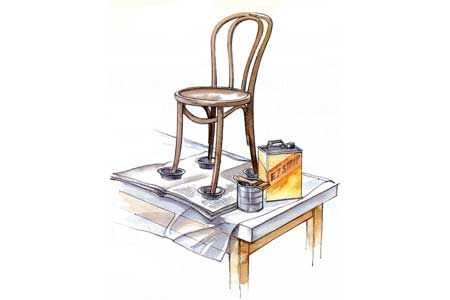Chemical strippers are powerful tools for refinishing furniture, but they can pose risks to your floors if not handled properly. This guide will walk you through how to protect your floors when using chemical strippers. From preparing your work area to disposing of stripper residue, we’ll cover everything you need to know to keep your floors safe during the stripping process.
What Are the Risks of Chemical Strippers?
Chemical strippers are potent solutions designed to dissolve and remove old finishes from wood and other surfaces. While effective, these products can harm unprotected surfaces, especially floors. The caustic nature of chemical strippers means they can eat through varnishes and stains and even damage the underlying wood or other flooring materials if left in contact for too long.
The main risk comes from the stripper’s tendency to run down furniture legs or drip off the edges of the piece being refinished. This runoff can quickly pool on the floor, potentially causing permanent damage if not addressed quickly.
Essential Materials for Floor Protection
To safeguard your floors while using chemical strippers, you’ll need to gather several materials. These items will create a protective barrier between your floor and any potential stripper runoff.
Drop Cloths and Newspapers
A heavy-duty plastic drop cloth serves as your first line of defense against chemical stripper damage. Lay this down over the entire work area to create a waterproof barrier. On top of the plastic, place several layers of newspaper. The newspaper will absorb any drips or spills, adding an extra layer of protection and making cleanup easier.
Disposable Foil Pie Plates
Disposable foil pie plates are an ingenious and cost-effective solution for catching stripper residue. These shallow, circular containers can be easily positioned under furniture legs to catch any runoff.
Other Protective Equipment
In addition to floor protection, you’ll need personal protective equipment (PPE) such as chemical-resistant gloves, safety goggles, and a respirator mask. These items will protect you from harmful fumes and potential skin contact with the stripper.
Step-by-Step Process for Safe Stripping
The following approach will help you protect your floors throughout the stripping process.
Preparing the Work Area
Start by clearing the area where you’ll be working. Remove any nearby furniture or objects that could be accidentally splashed with stripper. Ensure the room is well-ventilated by opening windows or using fans to circulate air. You need good ventilation when using chemical strippers due to their strong fumes. Also, many strippers can be caustic or toxic. Always read the instructions and warnings on all stripping products and follow instructions thoroughly.
Next, lay down your plastic drop cloth, ensuring it extends well beyond the area where you’ll be working. Cover the plastic with several layers of newspaper, which will absorb spills and simplify cleanup. Be thorough in your coverage to minimize the risk of the stripper seeping through to your floors.
Positioning the Furniture
Carefully place the piece of furniture you’re stripping onto the prepared work surface. If it’s a large item, enlist help to move it safely. Once in position, slip a foil pie plate under each leg of the furniture. Ensure that the furniture is stable to avoid any accidental tipping that could lead to spills.
Applying the Chemical Stripper
Before applying the stripper, put on your personal protective equipment. Using a bristle brush, apply a thick, even coat of stripper to the furniture. Work in sections to ensure thorough coverage, and watch out for drips or runs that might escape your brush. Take your time to apply the stripper evenly.
Proper Disposal of Stripper Waste
Responsible disposal of chemical stripper waste is crucial for both environmental protection and compliance with local regulations.
Environmental Considerations
Chemical strippers contain hazardous substances that can harm the environment if not disposed of properly. Never pour stripper waste down drains or on the ground. Instead, collect all residue, including soaked newspapers and used foil plates, for disposal.
Local Regulations and Guidelines
Check with your local waste management authority for specific guidelines on disposing of chemical stripper waste. Many areas have designated collection sites or special disposal days for household hazardous waste. Always follow these regulations to ensure safe and legal disposal and help maintain community health and safety standards.
Dealing With Accidental Chemical Stripper Spills and Drips
Despite your best precautions, accidents can happen. Knowing how to respond quickly can prevent lasting damage to your floors.
If stripper spills onto your floor, act fast. Blot up as much as possible with absorbent materials like paper towels or rags. Avoid spreading the spill by wiping. Instead, use a dabbing motion to lift the chemical from the surface. Immediate action can mitigate potential damage and prevent the chemical from setting into the floor.
Additional Tips for Floor Protection
These additional tips can provide further protection to your floors:
- Regular monitoring: Regularly monitoring the workspace allows you to promptly address potential risks before they become significant issues. Keep an eye on the integrity of your protective layers and catch basins.
- Physical barriers: Consider setting up physical barriers around the work area to prevent any accidental knocks or trips that could lead to spills.
- Emergency kit: Keep an emergency cleanup kit nearby, equipped with neutralizing agents, absorbent materials, and quick-access tools to handle any accidents swiftly.
Our Conclusion
Protecting your floors while using chemical strippers is a crucial step in any furniture refinishing project. By using the right materials, such as plastic drop cloths, newspapers, and foil pie plates, you can effectively contain stripper residue and prevent damage to your floors.
Always prioritize safety by using appropriate protective equipment and following local regulations for chemical waste disposal. With these precautions in place, you can confidently tackle furniture refinishing projects while keeping your floors in pristine condition.

